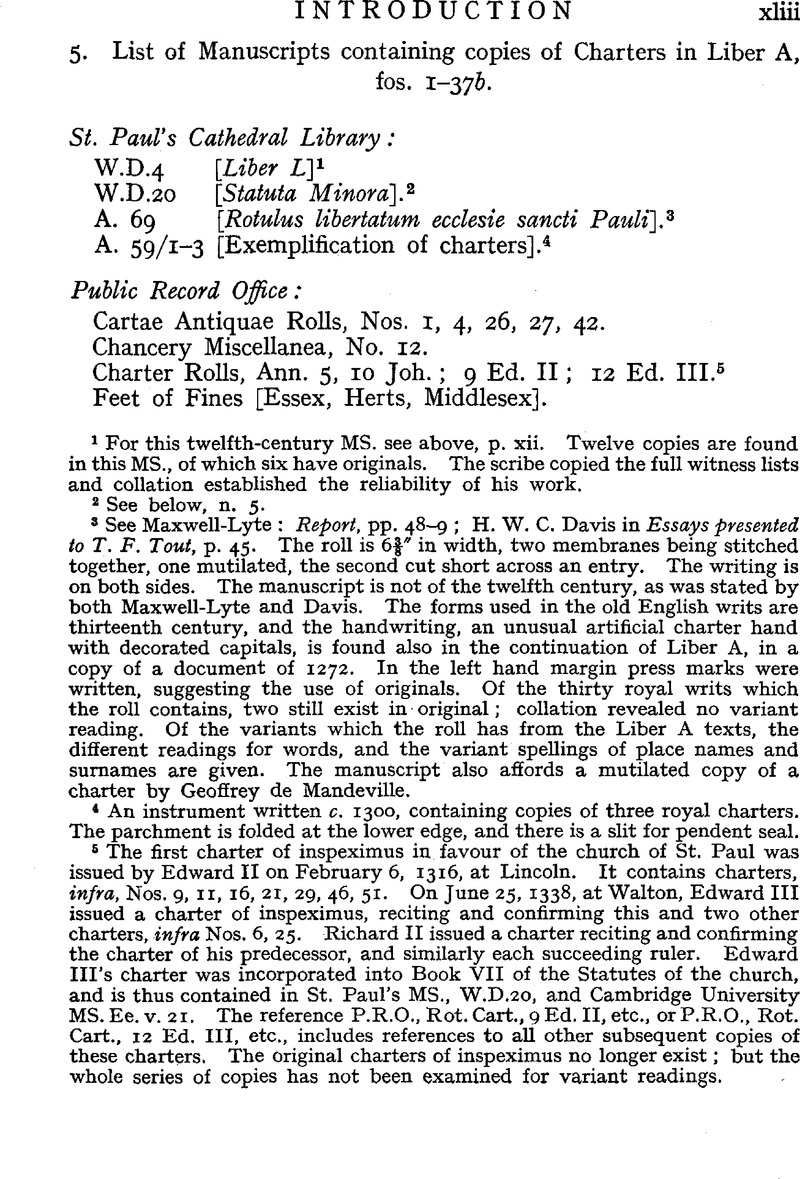No CrossRef data available.
Published online by Cambridge University Press: 24 December 2009

page xliii note 1 For this twelfth-century MS. see above, p. xii. Twelve copies are found in this MS., of which six have originals. The scribe copied the full witness lists and collation established the reliability of his work.
page xliii note 2 See below, n. 5.
page xliii note 3 See Maxwell-Lyte, : Report, pp. 48–9Google Scholar; Davis, H. W. C. in Essays presented to T. F. Tout, p. 45Google Scholar. The roll is 6⅜″ in width, two membranes being stitched together, one mutilated, the second cut short across an entry. The writing is on both sides. The manuscript is not of the twelfth century, as was stated by both Maxwell-Lyte and Davis. The forms used in the old English writs are thirteenth century, and the handwriting, an unusual artificial charter hand with decorated capitals, is found also in the continuation of Liber A, in a copy of a document of 1272. In the left hand margin press marks were written, suggesting the use of originals. Of the thirty royal writs which the roll contains, two still exist in original; collation revealed no variant reading. Of the variants which the roll has from the Liber A texts, the different readings for words, and the variant spellings of place names and surnames are given. The manuscript also affords a mutilated copy of a charter by Geoffrey de Mandeville.
page xliii note 4 An instrument written c. 1300, containing copies of three royal charters. The parchment is folded at the lower edge, and there is a slit for pendent seal.
page xliii note 5 The first charter of inspeximus in favour of the church of St. Paul was issued by Edward II on February 6, 1316, at Lincoln. It contains charters, infra, Nos. 9, 11, 16, 21, 29, 46, 51. On June 25, 1338, at Walton, Edward III issued a charter of inspeximus, reciting and confirming this and two other charters, infra Nos. 6, 25. Richard II issued a charter reciting and confirming the charter of his predecessor, and similarly each succeeding ruler. Edward III's charter was incorporated into Book VII of the Statutes of the church, and is thus contained in St. Paul's MS., W.D.20, and Cambridge University MS. Ee. v. 21. The reference P.R.O., Rot. Cart., 9 Ed. II, etc., or P.R.O., Rot. Cart., 12 Ed. III, etc., includes references to all other subsequent copies of these charters. The original charters of inspeximus no longer exist; but the whole series of copies has not been examined for variant readings.
page xliv note 1 Written in the fifteenth century. Contains copies of charters of inspeximus, but many of the charters incorporated are abbreviated.
page xliv note 2 A transcript of a fourteenth-century cartulary compiled by the Almoner of St. Paul's. It opens: hic incipiunt copie cartarum et aliorum munimentorum ad elemosinar' sancti Pauli London' pertinencium, per elemosinarium dicte ecclesie compilate, A.D. M.CCC.XLV. Sections only have been printed: Registrum Eleemosynarie D. Pauli Land', (ed. Maria Hackett, London, 1827).Google Scholar
page xliv note 3 A register of statutes, written in the fifteenth century. See p. xliii, note 5 above.